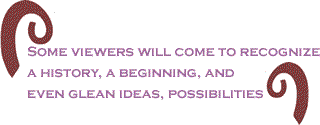Stuffed
bags of trash dumped in the big metal cans my grandfather
lifted and hauled down the back stairs to be placed in
the bins were understood to be unusable. Garbage. Stacked
hardback and paperback books and magazines held together
by rubber bands, carpets rolled or folded, toasters and
crock pots with cords carefully wrapped around them, and
freshly laundered and folded curtains were wrapped in
paper bags and placed just to the side of the trash cans.
Usually a note attached to the re-usable items started
with “please…” or a neighbor stepped out on her porch
to say “hello, Mr. Priestley” and point to what was “still
good.”
Transported
usable chairs, drapes, or tablecloths from the convent
or the rectory adorned rooms, windows, and tables throughout
the community.
Need
to repair a cranky refrigerator? Call my grandfather.
A stubborn car? My father. My mother’s croqueted dollies
“fancied” end tables and dressers while the meat my father
brought home on Fridays from the meatpacking company was,
by evening, seasoned New Orleans-,
Mississippi- or Georgia-style in other homes.
These
migrants from the South arrived in Chicago
before and during the Great Depression. My grandparents
from New Orleans saw the birth of their second child, my mother, in November
1929. Factory workers, meat packing workers (like my father),
truck drivers, elementary school teachers, maids, and
janitors (like my grandfather) - all considered themselves
a community of people for whom the other, the neighbor,
was family.
 Those
were the days of prosperity and wealth because re-usable
items did not go to waste and most important, not one
person’s skilled labor or creative ingenuity went to waste
for lack of a “license” or “degree.” Those were the days
before our desire to integrate consumed our community
and our integrity, before we became individuals ripe for
the picking by others with dubious intentions. Goodwill
and the necessities of life flowed from one person to
another. Thoughtfulness was a virtue. Poverty was unacceptable,
and shame was foolish and unnecessary. To trash or destroy
something that someone else could use would have been
un-neighborly. Mean-spirited! To drift into individualism
was akin to atrophy of the mind. “Lost!”
Those
were the days of prosperity and wealth because re-usable
items did not go to waste and most important, not one
person’s skilled labor or creative ingenuity went to waste
for lack of a “license” or “degree.” Those were the days
before our desire to integrate consumed our community
and our integrity, before we became individuals ripe for
the picking by others with dubious intentions. Goodwill
and the necessities of life flowed from one person to
another. Thoughtfulness was a virtue. Poverty was unacceptable,
and shame was foolish and unnecessary. To trash or destroy
something that someone else could use would have been
un-neighborly. Mean-spirited! To drift into individualism
was akin to atrophy of the mind. “Lost!”
***
At
harvest time in parts of Europe,
the growers take their share of Earth’s abundance. Workers
pick grapes, strawberries, apples, oranges and gather
potatoes and wheat. When the last of the workers has left
the field, the old and young, the office worker and nurse,
and the poor and middle class arrive.
“Gypsies
come from miles around. People who once held jobs and
find themselves unemployed, come to the fields.”
“There’s no shame.”
What
the growers cannot use is still usable, eatable, and there
is not anything about gleaning in this Old
World tradition that is shameful. To glean is to recognize
nature as the giver of life, a provider of substance.

A gleaner is one who gleans. Gleaning as a communal
practice is becoming extinct but “stooping has not vanished
from our sated society…Urban and rural gleaners all stoop
to pick up.”
The
eighty-three-year-old, Belgium-born, French filmmaker
and former gleaner, Agnes Varda, “dropped the ears of
wheat and picked up” a “small digital camera” to take
the viewer and fellow passenger from one French town to
another in search of myriad ways in which gleaners glean.
Some viewers will come to recognize a history, a beginning,
and even glean ideas, possibilities.
Volunteer
servers at Good Heart Charity Meals glean in the potato
fields in order “to help people in dire straits.”
Restaurant
chiefs glean. A “born gleaner,” France’s
youngest “inventive and thrifty” chief, Edouard Loubet,
gleans for his special sauces and for apples to “make
good spirits.” Why buy refrigerated fruits from Italy!
 The
camcorder in Varda’s hand documents the survival of possibilities
as she and we the viewers pass refrigerated trucks on
our way from one field to another. She intersperse her
travelogue with images, for example, of the French Realist
Jules Breton’s painting, Women Gleaning while the
film in my mind recalls the fields I pass over where the
world’s first peoples gleaned.
The
camcorder in Varda’s hand documents the survival of possibilities
as she and we the viewers pass refrigerated trucks on
our way from one field to another. She intersperse her
travelogue with images, for example, of the French Realist
Jules Breton’s painting, Women Gleaning while the
film in my mind recalls the fields I pass over where the
world’s first peoples gleaned.
In
the cities, citizens of all ethnicity and classes, glean.
When stores change their shelves, the people come to glean
over “good food” - food sometimes just a day or two past
their expiration dates.
It is shameful when food is allowed to rot!
But
one store owner Varda interviews thinks otherwise. He
is a man who believes he is adhering to the law!
He pitches bleach on the food placed behind his store!
Why, she asks. The young children and young adults behind
the store are “trespassing on private property.”
Where
does this mean-spiritedness come from? Where is his shame?
For
the most part, store owners do reserve food just past
expiration dates for all comers. The law in France looks favorably on
gleaning: If the food is no longer “owned” by anyone,
declares one judge, then the people are free to glean!
“Salvaging
is a matter of ethics,” says one man, a gleaner of “almost
100% of his food in the last 10 years.” He has a salary
but finds it “unacceptable to waste.”  We
live, he continues, in an “over consumer society [and]
this proves we are headed for a disaster.” He considers
his gleaning a form of activism. Resistance to greed and
consumerism!
We
live, he continues, in an “over consumer society [and]
this proves we are headed for a disaster.” He considers
his gleaning a form of activism. Resistance to greed and
consumerism!
Poubelle, ma belle! “Trash is beautiful!” It is not just a slogan but
also a campaign aimed at educating young children to sort
out the usable from the un-usable. In the process, the
children learn to be creative! Mobiles and collages made
of odds and ends hang decoratively in their classrooms.
And why not! Why venture to a high-priced school supply
store? Besides, what is the difference between the children’s
exhibition of mobiles created from odds and ends and the
American artist Sze’s exhibition of mobiles made of “lots
of bits from kitchen trash” at the Cartier Foundation
for Contemporary Art in Paris, except that Sze’s “junk
[is] high prized and high priced”!
The
shapes of objects are simple, says one artist, and sometimes
the same, but “possible variations are infinite.”
The
“homeless” are collectors of objects themselves. While
gleaning for food behind the markets, they also collect
discarded but usable stoves in which to cook the food
they share among other “homeless” members in the community.
But discarded scrap, too, becomes the foundation of artfully
designed shelters.
In
the cities, the “homeless” are not alone in their inventiveness
and thriftiness. Some urban gleaners collect items
to build “totem towers.” Others are amateur artists gleaning
for scraps to create collages. Loading up means
retrieving objects people leave behind their homes or
apartments. At night, Varda shows us, some citizens, couples,
students, individuals, drive while others walk through
the alleyways in search of the usable including televisions,
irons, stoves, refrigerators, dishes, sofas, and paintings.

On
one night, while we the viewer are witnesses, Varda finds
the remains of a glass clock. It is missing its hands.
But she picks it up. Later, at home, we see the clock
sitting on her mantelpiece between two porcelain cats.
Gleaning,
Varda implies, can be understood more broadly as a form
of resistance, a way of refusing to be boxed in by conventional
expectations; as such, it demands that we re-learn age-old
skills as well as supply individual creativity and initiative…we’ve
missed the point if we consider creative achievement and
practical survival to be entirely separate (Jake Wilson,
“Trash and Treasure,” Senses of Cinema).
What
shame is there in “stooping” as a “form of resistance”?
But what a shame it is to accept the existence of genetically
modified food as natural and strangling the fruitful production
of farmers. What a shame it is to purchase, in blissful
ignorance, clothes, household appliances, electronic gadgets
produced with global labor paid cheaply while corporate
executives receive millions in bonuses. What a shame it
is to be complicit in the destruction of Earth’s natural
resources. What a shame it is to foster atrophy of the
mind.
And
here I am among the gleaned bookcases, at my gleaned desk,
wondering why in the home of the brave, gleaning is left
to those labeled the “unfortunate,” the “homeless” when,
given the determination of corporate empire, we are all
the “unfortunate,” except those in ownership of the majority
of the world’s wealth. Why it is in the U.S. that the community most
marginalized and stigmatized is yet the one population,
a growing population, relying on its inventiveness and
thriftiness? Why are other communities, even communities
of the economically poor, living the nightmare of a consumer-driven
society, still cling to the mythical American Dream? Have
we not traveled for too long and too far off course down
this increasingly narrow road? The sign up ahead reads:
Dead End!
Are
there not whole communities, masses of others with open
eyes, brave enough, as the film Gleaners and I
asks, to “re-learn age-old skills” and “creatively” resist
before it becomes impossible to turn back and re-capture
what we have lost?
BlackCommentator.com Editorial Board member, Lenore Jean Daniels,
PhD, has a Doctorate in Modern American Literature/Cultural
Theory. Click here
to contact Dr. Daniels.

